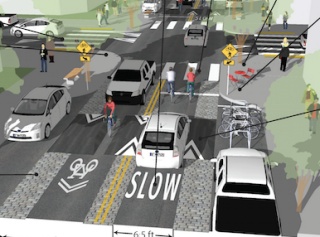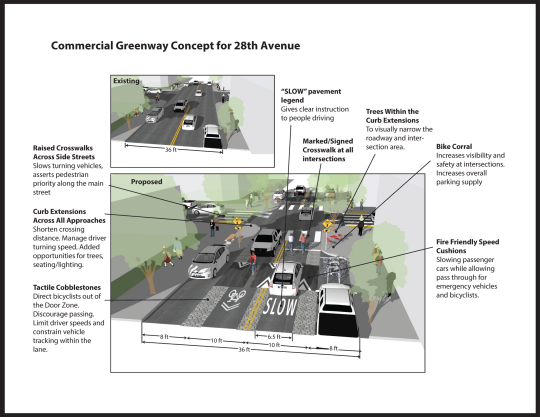
for NE/SE 28th Ave.
(Graphics by Paulsen/Falbo/Davis)
This post is part of our ongoing coverage of the 20s Bikeway Project. It was written by Kirk Paulsen, a member of the project’s stakeholder advisory committee. (He’s also a traffic analyst for Lancaster Engineering by day.)
Hello fellow BikePortland readers, we want your opinion!
But first, a bit of backstory…
I’m a member of the Stakeholder Advisory Committee (SAC) for PBOT’s 20s Bikeway project. As you know, the project so far has spurred a lively discussion, especially surrounding the central section along 28th Avenue.
Once the petition that was signed onto by dozens of businesses along and near 28th was brought up for discussion at the last meeting, I could sense the discussion was taking a step away from being rational. One reason was because all the attention became focused on the language within the petition that stated:
“We support a bikeway that does not remove curbside parking on 28th Avenue. We will continue to support any alignment that does not impact parking on 28th Avenue and in the meantime will continue to provide our own extensive accommodation of bicyclists in our district.”
The important bit of text missing in that phrase was “an entire side of” so that it would have then read: “We support a bikeway that does not remove curbside parking on an entire side of 28th Avenue…”
That exact phrase was never mentioned out loud or asked to be amended to the petition. I sensed that it was what the business representatives had meant to write/say, but never did. Through various discussions at the meeting, what they did ask for was a slower street that would be easy and safe for people to cross. They also wanted the street to be good for biking — they certainly don’t want to see all the bike traffic disappear and shift to 30th Avenue. And yes, the business owners on the committee also want car parking kept on both sides of the street.
The thing that stuck out to me though, was when they explicitly stated they’d be willing to give up some car parking spaces at many of the intersection approaches so that people could be seen when attempting to cross the street (this is known in the planning profession as “daylighting”). That’s when I realized the wording in their petition led people astray from what we could achieve as a group.

To achieve all of those goals on a street that is only 36 feet wide is extremely tricky, especially when all of the proposed design options suggest that the only way to provide a comfortable and modern bike facility is by separating modes. PBOT’s initial design recommendation would have provided that modern bike facility in only one direction of travel (southbound). No matter which design would eventually come to fruition, each option would result in painful losses for a portion of the stakeholders.
I’ll admit, I was disheartened to be involved with this public process only to find out that we wouldn’t be able to spend much time considering what could be done with the space where cars currently park on the street. Since the first meeting, I have spent much time thinking about what we could do with 36 feet of space that would please everyone. A plan that would: be seen as a huge win for biking; be feasible given our current state of politics; and convince business owners that dedicating a small portion of space on the roadway just for biking would be smart for their future.
This project is for 28th, but in many ways it is also a model of what could/should be done along Alberta, Division, Mississippi, etc.
The more I thought about it, the more I started to fear that the committee’s process was heading towards a solution that would introduce faster, unimpeded car speeds in at least one direction, more lanes (with varying traffic speeds) of traffic to walk across, and a bike facility (a buffered bike lane) potentially associated with reduced safety in the form of right-hooks (some from cars entering the neighborhood streets to search for parking that used to be on the main street). All of that in exchange for the loss of car parking on one entire side of the street.
Is that, I wondered, the best way to convince businesses that separating bikes and cars is a good idea? I understand, support, and advocate for better separation where it makes sense (i.e. Barbur, 33rd Avenue, etc.), but I’m not so sure it makes sense for this narrow of a street.
Delving deeper into shared space: Introducing the commercial greenway
The one design option that seemed to be missing from the table was the concept of ‘shared space’. Technically, 28th Avenue is already ‘shared space’. However, for the sake of comparison, let’s consider that to be one end of the spectrum. Jonathan recently wrote about a shared street that he experienced in the Netherlands. That street is ‘shared space’ on steroids and let’s consider that the other end of the spectrum.
Now, let’s take the “enhanced shared roadway” PBOT has proposed for 28th. If it was implemented today, it’d likely consist of sharrows, marked crosswalks, fire-friendly speed humps, and 20 MPH speed signs. That ‘shared space’ would be an improvement on today’s conditions, but we know we can do more to make the street more vibrant and livable. The unanswered question is what level of ‘shared space’ would the business community support?
After talking with a couple of the business representatives on the SAC, I had a good list of individual transportation components that they would likely support. Collaborating with my friends and colleagues Brian Davis and Nick Falbo, we took this list of individual components and combined them together to create a draft version of what could be Portland’s next big breakthrough for biking within town: ‘Commercial Greenways’
Basic details of the commercial greenway concept can be seen in the images below:
The commercial greenway concept acknowledges the concerns from the various stakeholders involved in the process, and in most cases turns these concerns into advantages that will make the street more pleasant and comfortable for all of us.
We think it’d be ideal to implement all those features as a part of this project, but that is simply not financially feasible. However, this vision of what the street could be like over time is necessary to understand what we need to do now in order to progress towards that vision. Overall, the design goal is to slow things down as much as possible keeping in mind that emergency vehicles are required to travel through the area.
We feel that the benefits below are just a sample of what could easily be achieved through an interim build-out of the proposed design, in addition to being even more robust once it’s fullly built-out:
Walking
- Curb extensions shorten the crossing distance.
- Marked (and possibly artistic) crosswalks increase visibility.
- Daylighting of intersection approaches increase visibility.
- People crossing 28th are only required to cross two lanes of traffic, all of which will be going a fairly slow and predictable speed.
- A physical barrier of parked cars between traffic and the sidewalk remains.
Biking
- This provides a direct, safe route through a main commercial district that will be comfortable for most riders – arguably the first such route in Portland.
- No risk of being right-hooked.
- Traffic will be much slower than today.
- People will be encouraged to ride in the middle of the lane through the use of tactile treatments within the door zone.
- The smooth portion of the lane should be wide enough to accommodate social riding of two abreast.
Driving
- The roadway will inform the driver that this is a very slow street through a number of roadway treatments used in conjunction.
- For being a slow street, it’ll be an easy street to understand what people are expected to do – go slow. It is one lane in each direction, simple as that.
- People biking will be in ‘easy to see’ areas, directly in front of or behind the driver, never beside the car or in blind spots.
Parking
- The overall parking supply will be increased, as bike corrals would replace some car parking spaces at intersection approaches to daylight the intersection and make it safer for people walking across the street.
- People biking along 30th will know that they can turn onto any minor street and bike corrals will be greeting them at most every intersection along 28th.
- People biking along 28th will have much more parking available to them as bike corrals will be at most every intersection.
- People driving will have most of the curbside parking retained along 28th. If that is full they’ll then be able to enter the neighborhoods to search for parking without any chance of right-hooking a person biking.
Ultimately, the moral of the story is that business owners are not against all options that would make 28th Avenue more comfortable for everyone. They like the individual ideas in our design, and hopefully they’ll be open to using many of them in combination. If that’s the case, we’ll need to convince PBOT that this would be a smart investment (both financially and politically). With any luck, they’ll consider replicating this concept on other narrow commercial streets throughout the city.
And the clock is ticking. We have just over 15 years until it is 2030. I believe we’ll never reach our goal of 25% of all trips by bike if we settle for this same fight every time we try to improve bike access on (and around) commercial corridors. As one BikePortland commenter recently put it “…for cycling to really go mainstream it has to go main street…” I wholeheartedly agree.
Thanks for staying engaged on this project. Tonight (Tuesday, May 20th) is the next (and possibly last) SAC meeting for the 20s Bikeway Project. We’re excited that PBOT will allow us to present this idea to the full committee.
The meeting is open to the public and takes place at Pacific Crest School (116 NE 29th) Colonial Heights Presbyterian Church (SE 28th and Stevens) at 7:00 pm.
Before the meeting tonight, we’d love to hear what you think. What’s the general consensus around the idea of a ‘commercial greenway’ along 28th Avenue? Let us know, and stay tuned!
— Read all our coverage of the 20s Bikeway Project here.



